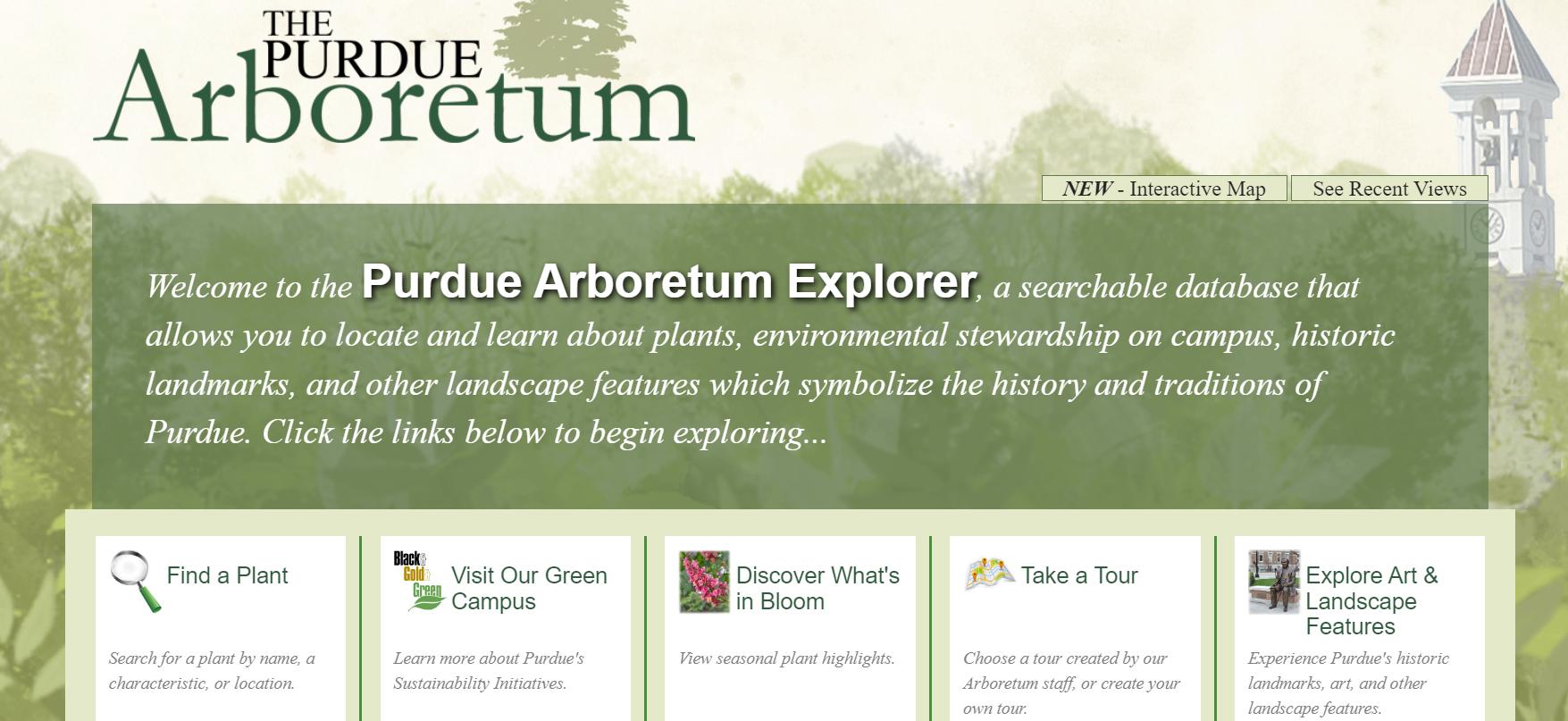Analyzing Genre and Form with the Purdue Arboretum Explorer
October 13, 2022
My recent first-year composition courses have featured a unit on narrative and genre. The unit culminates in an analysis essay that asks students to choose a cultural text—including but not limited to novels, films, video games, podcasts, etc.—and analyze its conventions in both generic and formal terms. While students may initially find the rhetorical nuances of both genre and form confusing, many already possess a rudimentary sense of both through their prior reading, viewing, and playing experiences. For instance, they can likely describe the differences between a country music album, an anime Netflix series, and a first-person horror video game. Given the proper terms, students will see that they can make claims about these texts as deliberate, rhetorical constructions.
One small-group activity in the Genre and Narrative Unit asks students to perform a low-stakes analysis of the Purdue Arboretum Explorer (PAE). The PAE is a website that catalogues plant species across Purdue’s West Lafayette campus, and it is a valuable digital tool not only for tracking campus biodiversity but also for making such information accessible to researchers, writers, and teachers.

Homepage for the Purdue Arboretum Explorer
Though many know the West Lafayette campus by its brickwork, brief use of the PAE demonstrates that one can encounter dozens of species just by stepping outside their dorm room; in fact, many students find species based on the location of their residence halls. The species featured on PAE are, quite literally, outside the classroom and alongside campus walkways, and when I introduce the activity and the website, I encourage students to reflect on this proximity. Analyzing the species featured on PAE thus brings the campus into the classroom, an important development in place-based composition classes (such as mine) that analyze environmental narratives.
When read as a digital rhetorical tool, the website’s construction is a rich object for analysis. In addition to pages on environmental history and sustainability at Purdue, the PAE offers an extensive database of various plant species—one could, as some of my students do, refer to it as an index or catalogue. Each species’ page has a photo, campus location, as well as extensive information about its scientific family, habit (the plant’s physical form), and other factors of interest to a botanical profile. Because each page is constructed similarly, certain conventions arise that enable us to read the website through a generic and formal lens.

Two plant profile pages on the Purdue Arboretum Explorer
When we begin the activity, I ask students to survey the website with their group for three minutes before selecting two plant species from two campus locations (Discovery Park and Central, North, South, or West campus). I then ask the groups to review their chosen species’ pages and respond to the following in a paragraph of approximately 250 words:
-
What are the plants in question? Where on campus can they be found?
-
What are some possible genres that fit the website’s description of the plants? Why?
-
What are three conventions shared between the plant pages?
-
What do these conventions “do” in making the plant pages legible for their audience?
Working together on a shared Google Doc, students answer these questions using the definitions of genre and form we have devised thus far in the unit. Even if the definitions are provisional at this point, reviewing the species’ pages challenges the students to transfer their knowledge of the genre and form to engage with evidence from the website. With this evidence, they can make claims about PAE’s purpose, such as: “While one convention on a PAE page serves X function, another serves Y.” With a topic sentence and additional framing, the students write what could become support paragraphs in a hypothetical analysis essay. Asking the students to write their responses in a shared Google Doc makes that hypothetical essay more real than not: the groups see their responses quickly fill blank space.
Perhaps unsurprisingly, what I have enjoyed most about this activity is student creativity. I teach effective analyses with an explicit attention to evidence and a specific discussion of its function in the text’s rhetorical situation. In other words, meaningful analytical writing makes strong connections between a text’s form, genre, and its conventions. Students see these connections emerge in species’ individual pages. One group from my Spring 2021 class analyzed the pages of the Cherry Plum and the Common Pawpaw trees. The group noted how each page uses maps to situate the user on campus while providing hyperlinks to information elsewhere on PAE. Each convention, the group noted, takes advantage of the website’s online form and database genre (we’re using “genre” provisionally here) to direct user engagement. A group from my Fall 2021 class chose the White Fir and the Radiant Flowering Crabapple. The group noted that each page presents an audio summary of the plant species’ profile that (potentially) enables more accessible engagement for visually impaired users. While these are but a few examples, they show how students can link knowledge about their local environment (as well as their institutional digital spaces) to the analytical skills fostered in ICaP’s first-year composition classrooms.